Welcome to Rethymno, on the north coast of Crete
Rethymno, Crete
Enthroned high above Rethymno, the striking, 16th-century Fortezza Castle dominates the cityscape of Crete’s third-largest city.
Rethymno is only about 30 minutes from Georgioupolis by public bus. First you will drive along the entire coastal plain, lined by our seemingly endless beach. Then your route takes you over a few foothills, and finally down to Rethymno.
As you arrive, you will already notice the distinctive features of the third-largest city in Crete: surrounded by lapping ocean waves, the historic centre is spread in its entirety along a peninsula, and there, at its northernmost point, a sprawling fortress rises up on a low plateau.
A long sandy beach stretches on for miles, starting right from the south-east edge of the old town. Here you can go right from city to sea and take a dip in hot weather; but since it’s even more comfortable to bathe from your hotel with us, your time here is better spent strolling through the historic centre.
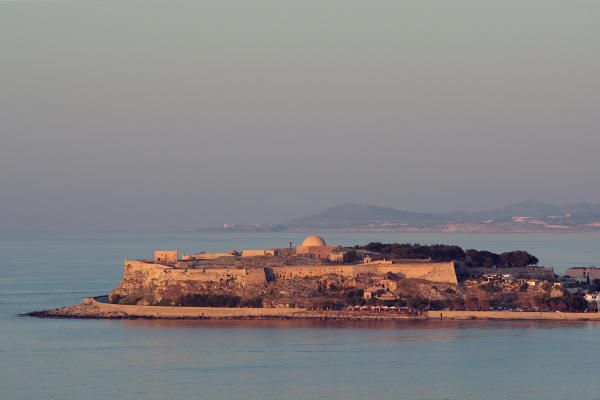
Surrounded by lapping ocean waves, Rethymno's old town is spread in its entirety along a peninsula, and there, at its northernmost point, a sprawling fortress rises up on a low plateau.
Here, you will notice that Rethymno is tranquilly provincial. The slight hustle and bustle of Heraklion is missing; the old houses here are much smaller than in Chania. Some of the streets seem almost endearingly rural with their floral decorations. You will also notice the multitude of minarets on the former mosques in the city precincts, exuding, together with the wooden bay windows on rows of residential houses, a touch of Oriental charm.
Unlike Chania and Heraklion, Rethymno was never the capital of Crete, rather it was always just a second-city in both Venetian and Ottoman times. The culture here, however, has always been vigorously upheld.
A child of the city, Athanasios Patelaros (1597-1654) rose to become the Patriarch of Constantinople, and Rethymno was also the birthplace of Pantelis Prevelakis (1909-1986), the second most important Cretan writer after Nikos Kazantzakis.
An annual Renaissance Festival has been celebrated at the castle since 1987, and the Carnival Parade on the Sunday of carnival weekend is the largest and most exuberant on the whole island. Moreover, Rethymno is also one of the sites of the University of Crete. Its School of Philosophy is located here.
A Day in Rethymno
A Tour of the Historic Centre
1 On the way into the old town
Rethymno bus station is located in the far south-western corner of the old town. From here, we recommend you head first of all 300 m north along the coast road and inhale the healthy, salt air right down by the surf - Thalassotherapy free of charge, so to speak.
Once you’ve gone past the stadium, turn right and you will promptly find yourself on a small square, the Platia Iroon Politechniou. It is bordered by the classicist architecture of the Prefecture Building (Nomarchia) and a police station. Take the short alleyway alongside the police station, and then turn right into Odos Melissinou street. Passing by a beautiful open air cinema, head on in the shadow of the sprawling castle, known here as the Fortezza. To get up to it, turn left into the short Odos Katechaki street, which leads directly to the castle gate.

2 The Fortezza fortress
Inside, Fortezza fortress is like a somewhat overgrown park, perfect for taking a breather in the silence. The whole stronghold dates back to the last quarter of the 16th century and was never overly developed. After all, it was mainly intended to serve as a refuge in times of siege and to be able to take in the city's population at the time of approximately 8,500 souls. A little forest grove with an open-air stage lies behind the entrance. This is the venue of performances taking place as part of the annual Renaissance Festival. You can also visit and walk through several cisterns, the restored interior of a simple mosque and a charming little church from the Venetian period.
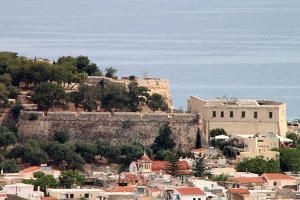
3 Café Terraces - Venetian Port
When you leave the Fortezza again, you will see a stately Venetian building right in front of you, which was home to the city’s Archaeological Museum until 2015. This is unfortunately now closed indefinitely. Take a left here, and descend onto the coast road, which runs just above sea-level. If you turn right onto the coast road, you will come by numerous café terraces right above the Aegean Sea, where you can finally enjoy a well-deserved coffee or a cold drink.
Afterwards, continue following this road down to the diminutive Venetian Harbour, considered one of the most beautiful historic ports in all of Greece. The narrow harbour entrance is flanked by a low Venetian lighthouse, and fish tavernas line the entire semicircle of the harbour basin. Don’t hold it against the waiters that they’re sure to call out to you and persuade you to stop by - these 'krachtes' are only doing their job after all.

4 Old Town: Loggia - Odeon Music School
From the south side of the harbour basin, where the cruise ships, including Crete’s last pirate ship, are moored, turn right, back towards the old town. What strikes you immediately is the elegant architecture of the venezianischen Loggia. Today, the State Directorate of Antiquities operates a museum shop there, where you can buy copies of artworks from numerous museums across Greece, including everything from certified replicas of ancient and Byzantine jewellery, to icons and statues in their original size. The museum is happy to ship your larger purchases home...
Now follow Odos Paleologou street, which starts from the front of the Loggia, and then turn straight into the picture-perfect, winding street of Odos Souliou with lots of wonderful little shops. It will take you to Platia Petachaki with the Nerantzes Tzami mosque. Today, it is home to the municipal music school, the Odeon. You might be in luck, there might be a rehearsal going on inside. Then you can simply go in and listen a while.
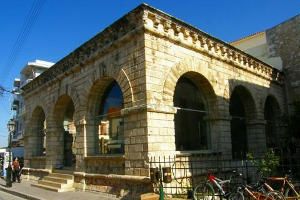
5 Hot spot - The Historical and Folklore Museum - Rimondi Fountain
Odós Vernardou street, which starts from this mosque, is the city’s hot spot in the evening. Here, you’ll find row on row of typical Rakadika where small live concerts are often held. They start serving good Cretan food at lunchtime.
AOn this street, you will come to The Historical and Folklore Museum of the city, housed in a 17th-century Venetian Palace. It displays the Cretan way of life and the working world of the 18th and 19th centuries.
A few steps further on in their archaic bakery, the charming Chatzparasko family follow their traditional trade, sadly now threatened with extinction: here they produce strudel dough. The baker takes small, folded balls of dough in his hand, swings them artistically through the air, so that they unravel, and then rolls them out thinly on a large table dusted with flour. You can buy the final product, Kataifi, there and then on site.
Now take a right where the next streets cross and right again after the small Panagia Evangelismou church, which is always open. Now you are in one of the main streets of the old town, the Odos Arabatzoglou. It takes you right onto a tiny square with plenty of cafés and an old, Venetian fountain, the Rimondi Fountain. It was originally covered by a domed structure, which unfortunately fell victim to modern urban planning. It was commissioned by the Venetian noble Alvise Arimondi in 1623.
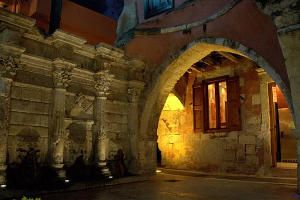
6 Main Square - City Park
If you now want to dine on fish at the Venetian Harbour, simply go back past the Venetian Loggia and you’ll be there in 200 m; but if you want to slowly make your way back to the bus station, now walk towards the south of the square taking Odos Ethnikis Antistaseos street with its many shops, and you will reach the main square of the city, the Platia 4 Martyron.
The sizeable Four Martyrs Church stands on the square and is well worth a visit. Inside, it is fully embellished with mural paintings in the Byzantine style. The statue of Kostas Giamboudakis, makes for a beautiful photo and a reason for reflection. In 1866 its namesake became the hero of Crete’s freedom. If you position yourself so that you can catch the small minaret in the background of your picture, then you can graphically demonstrate to your friends back home what he was fighting against: Ottoman foreign rule.
Now turn left on the Platia, and walk along the main road, Igoumenou Gavriil, another 600 m past the secluded city park until you reach the bus station.
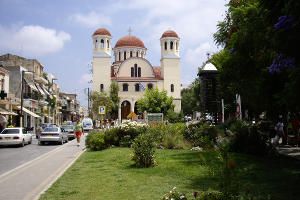
Museums of Crete
The Archaeological Museum of Rethymno
Open The Archaeological Museum of Rethymno in Google Maps
The city's old Archaeological Museum at the entrance to the Fortezza was closed in 2015. A new one is being planned, but is unlikely to become reality before 2022. In the meantime, some exemplary items of particular significance from the extensive collection are on display in the former Roman Catholic church of San Francesco. The exhibition may be small, but it has been lovingly arranged. It takes about 10-15 minutes to walk around.
San Francesco Church was originally the katholikon of a Carmelite Monastery and the burial site for many nobles and wealthy people in the Venetian period. The Ottomans integrated it into the complex of their Nerantze Mosque and used it as a poor house. The portal of the church is particularly worth seeing. It is in a Renaissance style, dating back to the late 16th century.
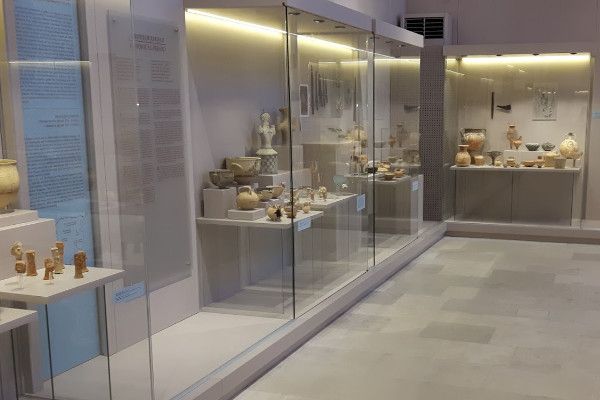
We recommend going around the exhibition anti-clockwise. Going past some stone-age artefacts, including some small Cycladic idols, as well as small items from Minoan times, you will come to three, free-standing sarcophagi from the Late Minoan period (1400-1300 B.C.). They come from the cemetery in Armeni oak grove, which is well worth a visit. The small sarcophagus is decorated with a floral motif. The midsize and the large sarcophagi have extremely vivid depictions of hunting scenes. The hunters use speers to catch deer and wild goats.
Opposite the sarcophagi, a display cabinet on the wall contains a krater (a ceramic vessel with two handles). You can clearly see three dancing warriors from the 10th century B.C. depicted on it in a "stick-man" style. The krater comes from Thronos on the edge of the Amari Valley. The figurine of a donkey carrying a loaded basket dates back to the Hellenistic period, and looks like a child's toy. Maybe a little Cretan played with it in the 3rd century B.C.?
A marble object in a display cabinet on the formwork wall appears extremely odd. At first glance it looks like a toilet seat. But it was an important invention for sailors: using this contraption, they were able to raise stuck anchors!
The last objects in the exhibition date back to early Christian and early Byzantine times (395-843), as does this "toilet seat". A hunting scene is again depicted here, this time as a fragment of a mosaic: a hunter with a sword and his dog is standing in front of a boar, intending to slay it. The mosaic was laid in the 4th/5th century in Lappa, known today as Argyroupolis.
Info: Archaeological Museum of Rethymno, Temporary Exhibition, San Francesco Church, Odos Ethnikis Antistaseos / Agiou Frangiskou, Rethymno Old Town, Tue-Sun, 10 am -6 pm, admission €2.
Discover heavenly Crete for yourself
An island full of surprises
A holiday destination for bathing enthusiasts, nature lovers, hikers, and those interested in history and culture. Today, Crete is one of the most popular tourist destinations in the Mediterranean - cosmopolitan yet mysterious.
Popular hotels on the sandy beach
The Corissia Hotels are situated within the tranquil, picturesque village of Georgioupolis right on the sandy beach. An ideal seaside resort both to relax and explore the island, because that is just what holidays on Crete are all about.
Let yourself be pampered
 OUR BEST
OUR BEST